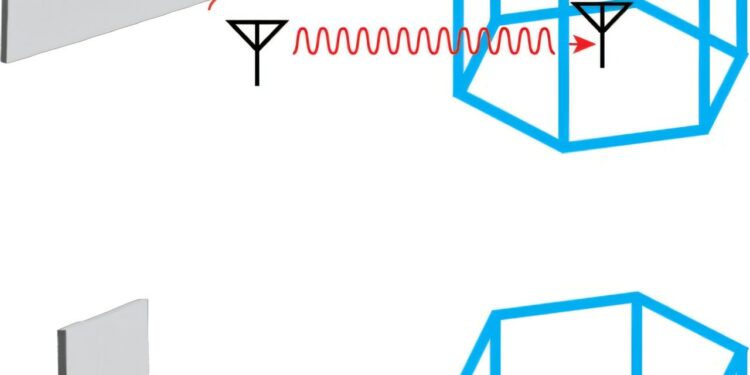This study demonstrates a passive metasurface technology which uses a mechanism varying over time with field effects to remove interference from the multiple journeys. Credit: Physical examination letters (2025). DOI: 10.1103 / Physrevlett.134.157001
The evolution of wireless communications and the miniaturization of electrical circuits have fundamentally reshaped our lives and the digital landscape. However, while we push towards higher frequency communications in an increasingly connected world, engineers are faced with increasing challenges from the propagation of multiple journeys – a phenomenon where the same radio signal reaches antennas receiving routes, generally with time delays and modified amplitudes.
Multiple interferences lead to many reliability problems, ranging from “ghosts” to television emissions to report discoloration in wireless communications.
The fight against multiple interferences has long been present two fundamental physical challenges for a long time. First, multiple signals share the same frequency with the main signal (leader), which makes filtering techniques based on ineffective conventional frequency. Second, the incident angles of these signals are variable and unpredictable. These limitations have made passive solutions particularly difficult to implement, because traditional materials linked by invariant -time linear responses (LTI) maintain the same diffusion profile for a given frequency, regardless of the moment the signal arrives.
In addition, without active control systems requiring additional food resources, angular dependence on conventional filters remains set at a given frequency.
In this context, a research team led by Professor Associate Hiroki Wakatsuchi of the Nagoya Institute of Technology in Japan developed a revolutionary approach to overcome these limits. Their article, co-written by Shunsuke Saruwatari from the University of Osaka and Kiichi Niitsu of the University of Kyoto, is published in Physical examination letters .
The team has designed a filtering system based on the passive metasurface which is released from the constraints of the LTI thanks to a locking mechanism varying over time. The design incorporates metasurface panels with internal coupled circuit elements, including field effect transistors (Mosfet) with metal-oxide oxide. The proposed system, which acts as a shield, can only selectively authorize the first incoming wave to cross while rejecting the late signals in other angles, all without requiring active biases or control systems.
Key innovation lies in the way the metasurface creates an answer varying in time without active components. Each unit cell, positioned on a panel facing a particular direction, contains a mosfet which acts as a dynamic switch, creating either an open circuit point or a short circuit as a function of the transistor’s door source tension. When the first signal arrives, it maintains the resonance of the metasurface panel to strongly transmit the incoming signal.
However, this first signal also triggers changes in the configuration of the internal circuit of unit cells in other panels, effectively modifying spatial impedance to reject subsequent signals from different angles.
This mechanism has been demonstrated both via simulations and experiments using a hexagonal prism structure with two unit cells of interconnected metasurface and a receiver positioned in the prism. The adjacent sides of the prism each received signals from different transmitters with a deadline, simulating a scenario of realistic multiple journeys.
In their experiences of proof of concept, the researchers have shown that their approach improved the magnitude of the first signal of around 10 dB while successfully removing subsequent waves, whatever their arrival. This breakthrough represents the first passive filtering design capable of overcoming the two physical limitations imposed by signals with the same frequency and the same variable incident angles.
“Our proposed work mechanism is completely different from previously reported conceptions,” notes Wakatsuchi. “This approach has advantages compared to conventional techniques, because ours does not require many calculations and modulation / demodulation circuits. Thus, it is suitable for low -cost application scenarios such as IoT devices.”
In addition, unlike existing material methods based on adaptive tables, this innovative strategy does not require additional direct direct energy sources. Although the current prototype uses simplified antenna designs and commercial diodes, the team estimates that performance can be further improved thanks to advanced semiconductor technologies and optimized configurations.
It should be noted that, beyond the resolution of multiple journeys problems, this approach between locking is promising to autonomously control various types of electromagnetic devices, potentially revolutionizing wireless communication systems for IoT applications where calculation resources are limited.
“The concept of our passive filter design can potentially create new types of new generation radio-frequency devices and applications, including antennas, sensors, images and reconfigurable intelligent surfaces”, explains Wakatsuchi. “In particular, our passive locking solution finds effective applications in low -cost versatile communication devices which are unable to adopt conventional approaches based on modulation or transformation of the signal due to their large calculation resources and expensive costs.”
With continuous progress in wireless communication technologies, the world can become more and more interconnected.
More information:
Kaito Tachi et al, Selective Metasurface of the Multipath signal: locking mechanism varying in passive time to vary the spatial impedance for signals with the same frequency, Physical examination letters (2025). DOI: 10.1103 / Physrevlett.134.157001
Provided by Nagoya Institute of Technology
Quote: Smart surfaces could represent an unequal solution
This document is subject to copyright. In addition to any fair program for private or research purposes, no part can be reproduced without written authorization. The content is provided only for information purposes.



